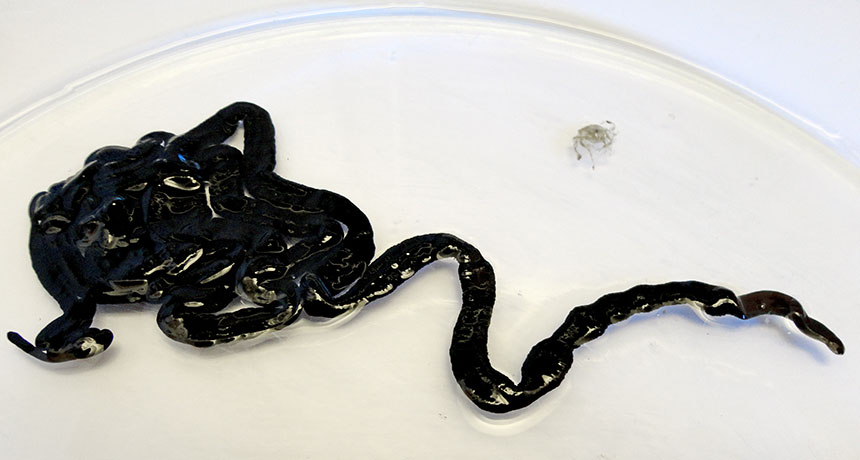Chemicals from the world’s longest animal can kill cockroaches
Poisons in this sea worm’s slime can knock off invasive green crabs, too

A bootlace worm glides along in its mucus. New research reveals that this mucus contains poisons that can paralyze or kill cockroaches and invasive crabs.
ERIK JACOBSSON
By Susan Milius
Bootlace worms boast spooky-stretchy bodies. Their secret: They also secrete a family of toxins new to science. These poisons might one day inspire novel ways to control noxious pests, such as cockroaches.
Tests first identified the toxins in the mucus coating one bootlace species. It holds the record as the world’s longest animal, notes Ulf Göransson. At Uppsala University in Sweden, he studies medical products that come from natural sources. This champion marine worm, Lineus longissimus, can stretch up to 50 meters (164 feet). That’s longer than an Olympic-size pool. The worm coats itself in mucus that smells a bit like iron or sewage. This goo holds small toxic proteins that have now been dubbed nemertides. Those poisons also have shown up in 16 other species of bootlace worms.
Göransson and his colleagues shared their discovery March 22 in Scientific Reports.
These nemertides poison by attacking some of the tiny channels in cell walls. These channels control the flux — flow rate — of sodium moving in and out of a cell. Much vital cell business depends on the right flux through these sodium channels, as they’re called. Among that important business: cell-to-cell communication.
The researchers injected small amounts of one nemertide into invasive green crabs (Carcinus maenas). The toxin permanently paralyzed or killed these animals.
“This study certainly has a lot of novelty to it, since marine worms are a tremendously neglected area of venom research,” says Bryan Grieg Fry. He works at the University of Queensland in Brisbane, Australia. There, he explores how animal poisons appear to have evolved.
Unlike earthworms, the 1,300 or so species of bootlace — or ribbon — worms have no segments. Some scientists give these animals their own branch, call Nemertea, on the animal family tree. Bootlace worms have a brain but no lungs. Like many other slender marine creatures, these worms breathe directly through the skin. They predators that dine on crustaceans, mollusks and other worms.
One has to marvel at how they can expand and contract their bodies. A 10-meter [33 foot] L. longissimus “can be held in your hand as a slimy heap,” notes study coauthor Malin Strand. She’s a marine biologist at the Swedish University of Agricultural Sciences in Uppsala. She estimates these worms could live 10 years “or maybe much longer.”
How bootlace worms use their toxins isn’t clear. The stringy creatures aren’t easy to keep in captivity for study, Strand says. She has some worms in her lab that have chosen to eat no more than once in three to four years.
Göransson proposes that their toxic mucus might make a useful defense. He has seen videos with the worms stretched upon the seafloor. “If you’re a crab or a fish, it must be tempting to take a nip,” he says. However, there’s little sign of anything pestering these worms.
He once tried some bare-handed contact with a small lab specimen. He didn’t feel much of anything. He’s been warned, though, about “tingling.” Just in case, Göransson now wears gloves.







